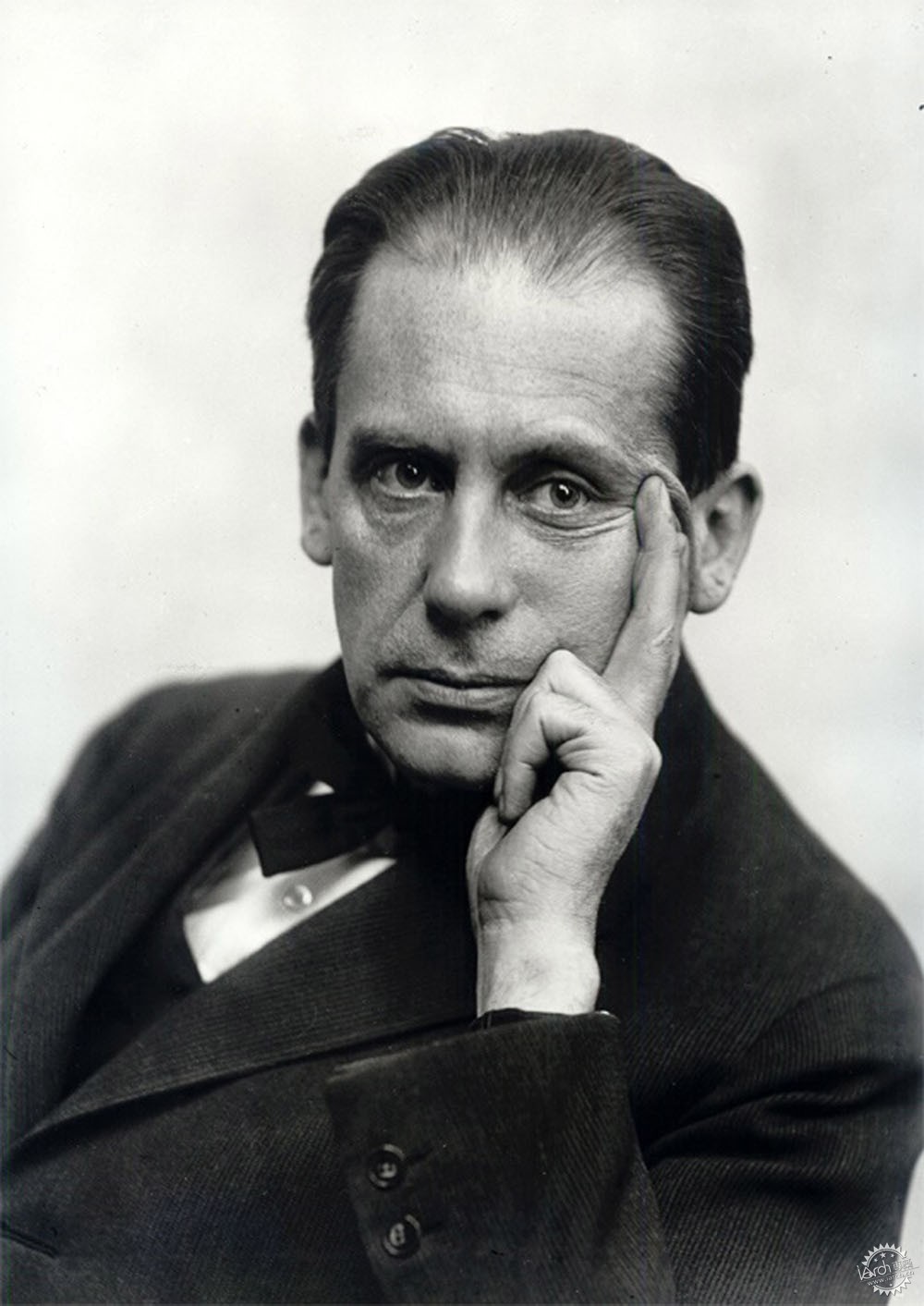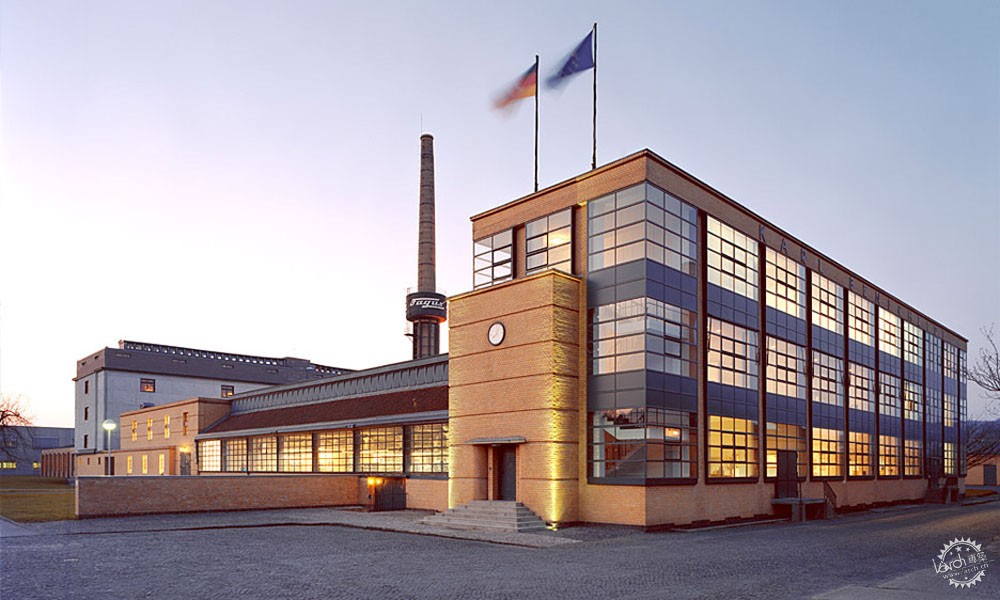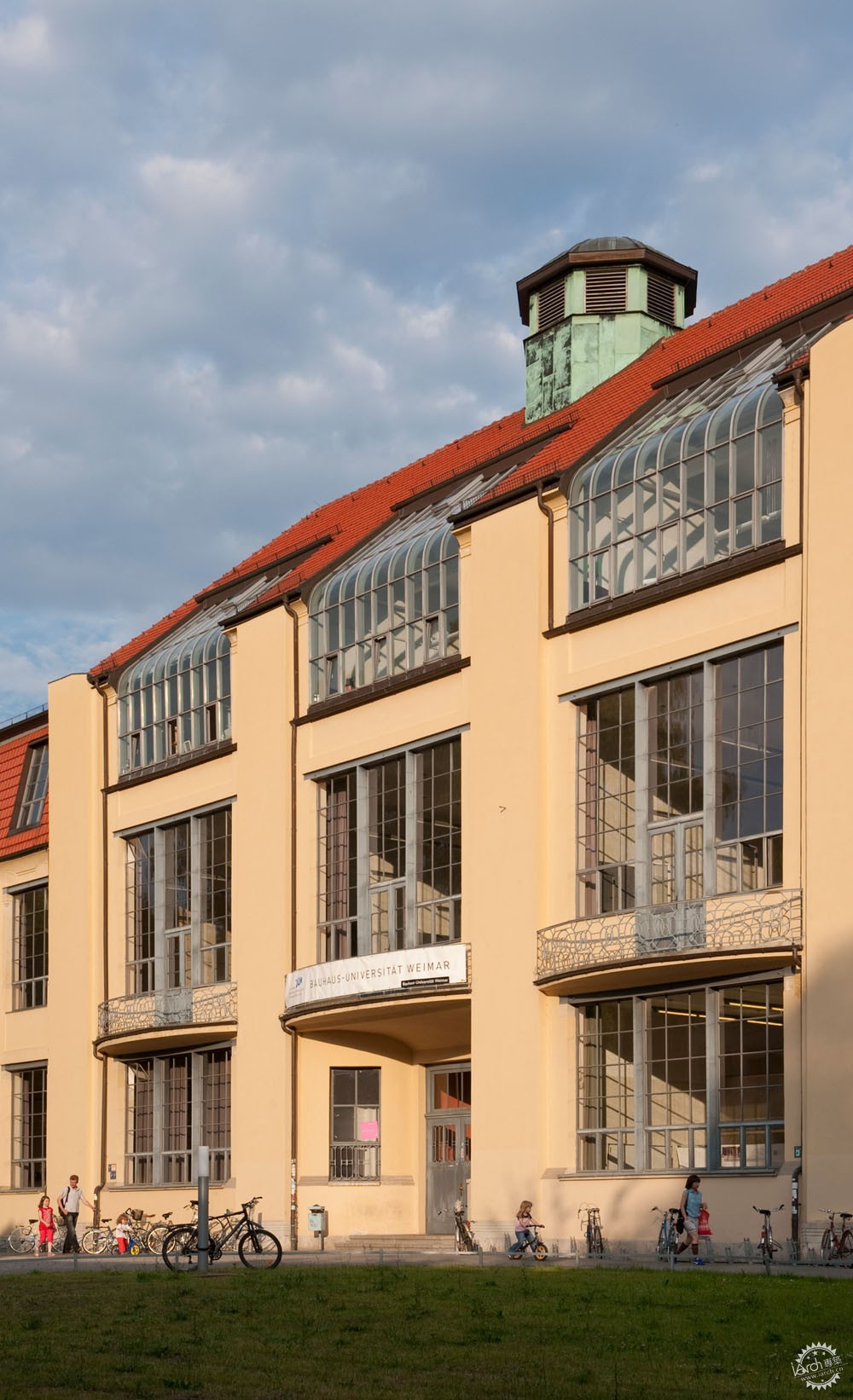
创立包豪斯的思想者——瓦尔特·格罗皮乌斯
Walter Gropius: the ideas man who founded the Bauhaus
由专筑网王帅,蒋晖编译
德国建筑师瓦尔特·格罗皮乌斯在1919年创立了公立学校包豪斯,当我们探索包豪斯学校的百年历史时,我们看到了一位有远见的人,他让大众接触到艺术,让艺术不再是少数人的奢侈品。
很多文章与著作之中都不断描述他是20世纪艺术、设计和建筑史上最重要的流派之一的创始人和建设者,但是他却不会绘画。
不管是否是由于这个缺点或者是为了统一艺术的宏伟愿望,合作是瓦尔特·格罗皮乌斯一生中的一个主题。他是一个有思想的人,但并不总是有能力去实现这一目标。
他从付钱给大学生完成他的绘画,再到把一些现代主义最神秘的人物带入他的轨道,这是他所拥有的奇迹般的才能。
包豪斯学校将艺术、建筑和工艺结合在一起,他们追求创作完整的艺术作品——这正是他带给这所学校的基本原则。
格罗皮乌斯在Peter Behrens的办公室所开启了职业生涯
格罗皮乌斯出生于1883年的柏林,家境优越,他不是他们家族第一个建筑师,他的叔叔Martin(1824-1880)在建筑行业也非常出名。
事实上,瓦尔特·格罗皮乌斯在完成学位之前就辍学了,在一年之后的1908年,前卫派的赞助人Karl-Ernst Ostenhaus介绍他进入了建筑师Peter Behrens的办公室。Peter Behrens是德意志制造联盟的创始人之一。
German architect Walter Gropius founded the Bauhaus in 1919. As we continue our Bauhaus 100 series exploring the school's centenary, we profile the man who had a vision to make art accessible to the masses, not just a luxury of the few.
There is something poetic to the often-repeated story that the founder and builder of one of the most important schools in the history of 20th century art, design and architecture could not actually draw.
Whether sparked by this particular shortcoming or a grander desire to unify the arts, collaboration is a running theme in the life of Walter Gropius, an ideas man who did not always have the means to deliver.
It is something he had a miraculous talent for, from paying students at college to complete his drawings, to bringing some of modernism's most mythic characters into his orbit.
It became the underlying principle of the Bauhaus, a school that combined the education of arts, architecture and craft, with the vision of producing complete works of art.
Gropius began career in office of Peter Behrens
Gropius was born in 1883 to wealthy Berlin parents. He wasn't the first Gropius to train as an architect – his great-uncle Martin (1824-1880) has also made a name for himself in the industry.
Walter Gropius actually dropped out of college before finishing his degree. A year after leaving, in 1908, a recommendation from patron of the avant-garde Karl-Ernst Ostenhaus landed him in the office of architect Peter Behrens, a founder of the Deutsche Werkbund association.

格罗皮乌斯于1919年起草了包豪斯宣言/Gropius drafted the Bauhaus manifesto in 1919. Photo is by Louis Held, taken in 1919
那时,年轻的格罗皮乌斯走进了Behrens的事务所,与此同时,路德维希·密斯·凡·德·罗(Ludwig Mies van der Rohe)也在1908年加入该事务所,两人相互竞争,又互为好友。随后勒.柯布西耶(Le Corbusier)也于1910年加入,在这一年格罗皮乌斯离开了该事务所。
Behrens与AEG公司的合作对象不仅停留在为柏林开创性的涡轮机大厅等建筑工作,还有从照明到办公室文具,Behrens将传统手工艺融入工业化,这无疑对包豪斯的总体设计精神产生了影响。
德国法古斯工厂开创了格罗皮乌斯的职业生涯
格罗皮乌斯于1910年离开了Behrens的事务所,之后与Adolf Meyer一起在波茨坦建立了他们自己的工作室。
尽管Meyer在工作室扮演着至关重要的角色,格罗皮乌斯却称他只是办公室经理,而格罗皮乌斯却担当着对外的全部角色。在1913年,两人完成了位于阿尔费尔德的法古斯工厂这一项目,这座建筑让格罗皮乌斯声名鹊起。
This pushed a rather green Gropius not only into the world of Behrens, but of Ludwig Mies van der Rohe, who also joined the studio in 1908, (and with whom Gropius would develop a famous cordial rivalry) and possibly Le Corbusier, who joined in 1910, the year Gropius left.
Behrens' work with the Allgemeine Elektricitäts-Gesellschaft (AEG), not only for buildings like the seminal Turbine Hall in Berlin-Moabit, but everything from lighting to office stationary, as well as his involvement in the Werkbund integrating traditional crafts into industrialisation, no doubt played a role in influencing the Bauhaus' total design ethos.
Fagus Factory established Gropius' career
Gropius left the studio of Behrens in 1910 to establish his own office in Potsdam-Neubabelsberg with Adolf Meyer – another introduction made via Behrens.
Despite Meyer's no doubt crucial role in the firm, Gropius described him as "merely the office manager", taking on any public-facing roles himself. In 1913, the duo completed the building that effectively made Gropius' name as an architect: the Fagus Factory in Alfeld.

位于阿尔费尔德的法古斯工厂让格罗皮乌斯声名鹊起/Gropius' Fagus Factory in Alfeld made his name. Photo is by Carsten Janssen
格罗皮乌斯的作品与Behrens的作品相类似,这些作品是都设计师与工业家密切合作的结果,它们更巧妙地处理了工业设计的要点。法古斯工厂是格罗皮乌斯系列作品中的第一部作品。早在1936年,佩夫斯纳就曾高度赞扬了法古斯工厂,他称其为“前所未有的内外开放性和连续性”。
格罗皮乌斯为1914年的第一次德国工业同盟展览设计了样板工厂和办公室,这些作品也是即将到来的标志性建筑,它将现代主义与传统的不朽的思想融合在一起。
格罗皮乌斯的设计项目在一战爆发后被迫暂停。1916年,当他还在西部阵线服役的时候,他向图林根大公国提交了一份提案,他提出“建立一所能够为工业、贸易和手工艺提供艺术指导的学校的建议”,因此,他在1919年被任命为魏玛美术学院的教授。
格罗皮乌斯在1919年建立包豪斯学校
从战争结束到担这一教职期间,格罗皮乌斯参与了早期包豪斯思想的几个小组:表现主义艺术与建筑的Novembergruppe团体(该团体的名字来源于德国革命,他们创作支持社会主义革命的作品),布朗诺陶特在1918年12月创立的Arbeitsrat fur Kunst团体(艺术工作委员会),还有乌托邦Glaserne Kette团体(Glass Chain)。
据说Taut在意识到他们的乌托邦思想的局限性之后,离开了艺术工作委员会。之后,格罗皮乌斯于1919年替代Taut担任委员会主席,由此更新了该团体的思想,正如传单上的宣称:“艺术和人民必须形成一个实体。艺术不再是少数人的奢侈品,而应该成为能够被更广大的群众所喜爱和体验的。我们的目标是在伟大的建筑之翼下成为艺术联盟。”
It was the first in a string of works that, akin to Behrens, resulted from close collaboration with industrialists, dealing more artistically with straightforward industrial briefs. Already in 1936, Pevsner was lauding the Fagus factory's "unprecedented sense of openness and continuity between inside and outside".
The model factory and office designed for the first Werkbund exhibition in 1914 was also a sign of things to come, merging modernism with more traditional ideas of monumentality.
Gropius' practice was put on hold following the outbreak of the first world war. But while still serving on the Western Front in 1916, he submitted a proposal to the Grand Duchy of Thuringia, setting out his "recommendations for the establishment of a school that could provide artistic guidance to industry, trade and the crafts", which would some years later lead to his appointment as professor at the Weimar Academy of Fine Arts) in 1919.
Gropius established the Bauhaus in 1919
Between the end of the war and taking up this teaching post, Gropius became involved with several groups key to the early Bauhaus idea: the Novembergruppe of expressionist artists and architects (who took their name from the month of the German Revolution and produced work that aimed to support a Socialist revolution), the Arbeitsrat fur Kunst (Work Council for Art), founded by Bruno Taut in December 1918, and the Glaserne Kette (Glass Chain) series of utopian correspondence, also initiated by Taut.
When Taut left the Work Council for Art, supposedly after realising the limits of their utopian ideas, Gropius took over as chairman in 1919, renewing its vision. As a flyer declared: "Art and the people must form an entity. Art shall no longer be a luxury of the few but should be enjoyed and experienced by the broad masses. The aim is an alliance of the arts under the wing of great architecture."

格罗皮乌斯在魏玛建立了第一所包豪斯学校/Gropius established the first Bauhaus school in Weimar. Photo is by Christoph Petras
包豪斯宣言也在同年起草,当时,格罗皮乌斯与相关部门谈判,将美术学院与解散的工艺美术学院合并,在魏玛市建立"公立包豪斯学校"。
在宣言中,格罗皮乌斯阐明了学校的目标和原则。该宣言声明“包豪斯人努力使工艺与美术重聚-雕塑、绘画、应用艺术和手工艺品-作为新建筑的永久元素。”
这所学校直到1927年才有了正式的建筑系。包豪斯的学生们普遍地用物质和形式进行尝试,他们非常强调直觉。
如果说包豪斯成为僵化的、白色渲染的国际风格的代名词,那么它的早期则更多的是表现主义风格。
格罗皮乌斯也经常雇用包豪斯学生来继续他的创作,例如,在1921年完成的Sommerfeld住宅,1922年完成的魏玛政变受害者的纪念碑(该作品格罗皮乌斯只画了一张草图)。上述作品都是令人惊讶的手工作品和表现主义作品。
对于包豪斯迫使格罗皮乌斯辞职的批评
Adolf Sommerfield 是锯木厂的老板和建造商,他是格罗皮乌斯的伟大支持者,他参与了格罗皮乌斯为实业家设计的项目,Sommerfield住宅是第一次真正的包豪斯合作,约瑟夫·阿尔伯斯设计窗户,Joost Schmidt设计木梁,Marcel Breuer设计家具。
有些人将这种奢侈的手工艺品的展示视为对战争的反应,这也许动摇了格罗皮乌斯对技术潜力的信念,可悲的是,Sommerfield住宅和魏玛纪念碑都无法在第二次世界大战中保存下来。
格罗皮乌斯在1919年的宣言中称“我们都得回去干手工活了!”但在1924年的宣言却变成了“有意识地回到旧的手工工作将是…一个过时的错误”。
The Bauhaus manifesto would be drafted that same year, when Gropius was able to negotiate the merging of the Academy of Fine Arts with the disbanded School of Arts and Crafts, creating the Staatliches Bauhaus in Weimar.
In the manifesto, Gropius set out the objectives and principles of the school, stating that "the Bauhaus strives to reunite arts and crafts – sculpture, painting, applied art, and handicrafts – as the permanent elements of a new architecture".
The school would have no formal department of architecture until 1927, instead seeing students experimenting more generally with material and form, with great emphasis placed on intuition.
If the Bauhaus became synonymous with a rigid, white-rendered international style, its early years were far more expressionist.
Gropius continued his own practice, frequently employing Bauhaus students, and two works, the Sommerfeld Residence, completed in 1921, and a Memorial for the Victims of the Kapp Putsch in Weimar (this one Gropius actually sketched), completed in 1922, are both surprising works of handcraft and expressionism.
Criticisms of the Bauhaus force Gropius to resign
Sommerfield continued Gropius' lineage of projects for industrialists – Adolf Sommerfield was a sawmill owner and builder, and a great supporter of Gropius - and was the first true Bauhaus collaboration, with Josef Albers designing its windows, Joost Schmidt designing its wooden beams and Marcel Breuer designing furniture.
Some have read this lavish display of handcraft as a reaction to the war, which perhaps shook Gropius' belief in the potentials of technology – tragically, neither the Sommerfield Residence or Weimar Memorial would survive the second world war.
But it did not take long for Gropius' 1919 declaration, "all of us must go back to handwork!", to become, in 1924, "a conscious return to the old handwork would be…an atavistic mistake".

格罗皮乌斯设计的德绍包豪斯学校被标榜为新建筑/Gropius' design of the Bauhaus School in Dessau was billed as a new architecture. Photo is by Tadashi Okochi
这是学校重新定位的结果,格罗皮乌斯将现代建筑的标准化和国际目标在国际建筑展览会上推向了最突出的位置。
这一转变引起了各界对学校的批评,其中很大一部分批评来自贸易和手工艺组织,从而导致了学校的经费被大幅度的削减,这让作为国家议会的右翼成员受到了更大的影响。
1925年,格罗皮乌斯本人被要求辞职,为了挽救这所学校,双方开始了谈判。萨克森-安哈尔特州的德绍出价最高,这为建造格格罗皮乌斯最著名的作品铺平了道路。1926年建造的包豪斯学校,成为了新建筑的象征。
格罗皮乌斯在1928年离开包豪斯学校,由Hannes Mayer和Mies来接替他在柏林的工作。后来由于来自极右势力的政治压力越来越大,这所学校在1932年关闭。
格罗皮乌斯在美国成立建筑师合作组织
格罗皮乌斯最初对纳粹夺取权力无动于衷。他希望包豪斯的功能美学能成为这个新政权表达自己的一种手段,于是在1933年,格罗皮乌斯参加了新的帝国银行的设计投标。
但事实上,新的法西斯政权对于现代主义的兴趣不大。在 Maxwell Fry的帮助下,格罗皮乌斯以短暂的意大利之旅为借口,于1934年逃往英国。
尽管为英国包豪斯提供了帮助,但格罗皮乌斯在英国并没有取得太大的成功,在Fry事务所待过一段时间后,格罗皮乌斯在1937年前往美国,并被任命为哈佛大学教授,一年后成为哈佛大学的建筑系主任。1945年,他在美国发起了建筑师合作组织(TAC),其中的成员有Norman,Jean Fletcher,John 和Sarah Harkness,该组织成为了战后现代主义最成功的组织之一,他们设计了一系列名留青史的作品,例如马萨诸塞州六月山和哈佛大学研究生院。
格罗皮乌斯于1969年在波士顿去世,建筑师合作组织(TAC)一直延续到1995,格罗皮乌斯的工作,虽然并不总是带有他自己的印记,但与包豪斯本身一样,很大程度上归功于他在合作中所看到的力量。
This was the result of a re-orientation for the school, which pushed standardisation and international goals in modern architecture to the fore in the International Architecture Exhibition, staged by Gropius.
This shift saw criticisms of the school rise – much of it ironically from trade and craft organisations – and the school's funding was drastically cut, as right-wing members of the State Assembly gained greater influence.
In 1925 Gropius himself was asked to resign, and in a bid to save the school, negotiations began with alternative locations. Dessau in Saxony-Anhalt made the best offer, and paved the way for the construction of Gropius' most famous works, the Bauhaus itself and the houses for its masters in 1926, built as symbols of a new architecture.
Gropius left the Bauhaus in 1928 in the hands of Hannes Mayer and subsequently Mies, to continue his own practice in Berlin. The school would close in 1932 following increasing political pressure from the far-right.
Gropius set up The Architects Collaborative in USA
Gropius was initially indifferent about the seizure of power by the Nazis. There was a hope that the functional aesthetic of the Bauhaus could be a means for this new regime to express itself, and in 1933 Gropius entered a competition for a new Reichsbank.
But it soon became clear that there was little interest in modernism as the aesthetic language for this fascist regime. With the help of Maxwell Fry, Gropius, under the pretext of a short trip to Italy, fled to England in 1934.
Despite offers of support for an English Bauhaus, Gropius' move there was not hugely successful. After a stint in the office of Fry, Gropius moved to the USA in 1937, appointed as professor at Harvard and just a year later becoming Director of the Department of Architecture. It was here in 1945 that Gropius would found The Architects Collaborative (TAC), which included Norman and Jean Fletcher and John and Sarah Harkness, and became one of the most successful firms in postwar modernism, designing an impressive roster of works, including Six Moon Hill in Massachusetts and Harvard Graduate School.
Gropius died in Boston in 1969, but TAC remained in operation until 1995. Its work, although not always bearing the stamp of Gropius himself, owes a huge amount, like the Bauhaus itself, to the power he saw in collaboration.

Dezeen举办的“包豪斯100”系列探讨了学校的持久影响/Dezeen's Bauhaus 100 series explores the enduring influence of the school
主插图:Vesa Sammalisto,其它插图:Jack Bedford
Main illustration is by Vesa Sammalisto, additional illustration is by Jack Bedford.
|
|
